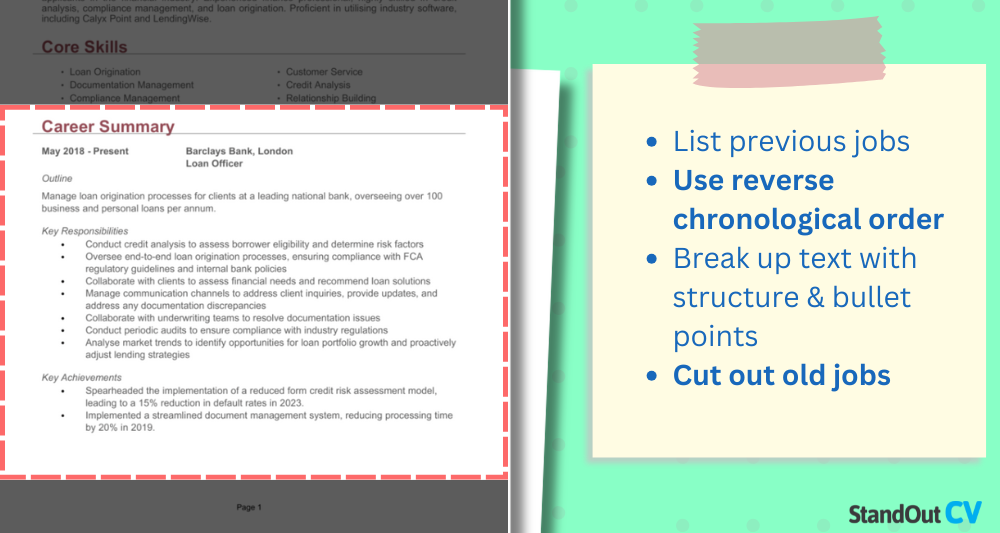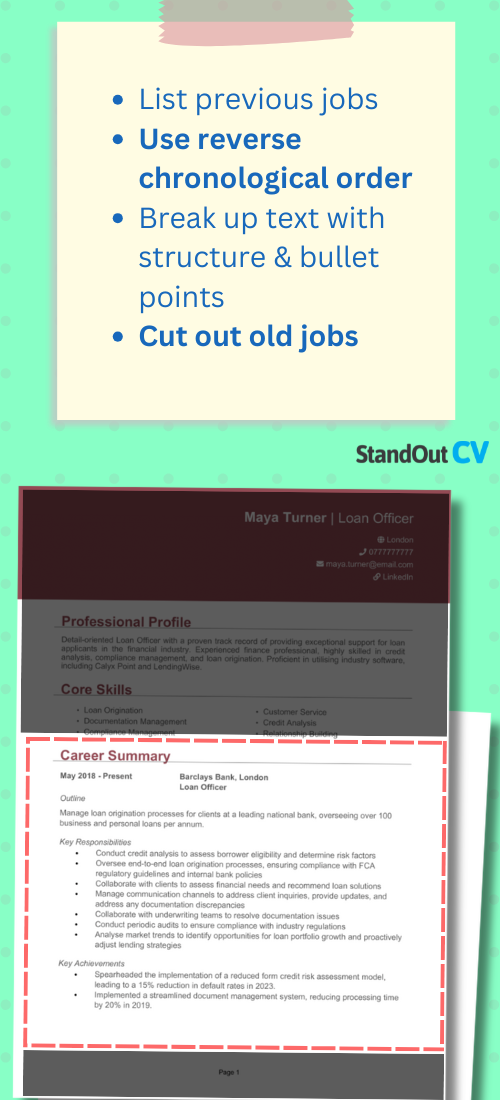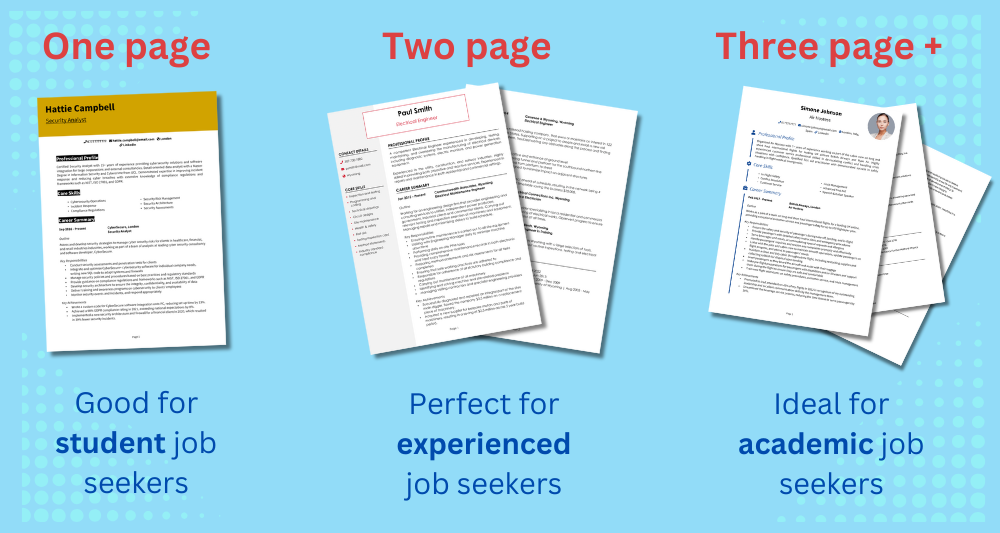Whenever I reviewed CVs, the section I focused on most was the work experience.
It told me not just what someone had done, but whether they could continue that track record and deliver the same results for the role I was hiring for.
Your work history is the heart of your CV, and it’s where you prove your value.
I’ll show you how to write your work experience section in a way that’s tailored to each job and clearly demonstrates the impact you’ve made throughout your career.
And that is how you will land interviews and get hired.
What work experience should you include?


First things first, the work experience you include should be listed in reverse chronological order, with the newest stuff at the top – this is the most relevant to your skillset.
There’s no need to list your whole job history – what you choose to highlight is all down to how relevant it is to the roles you’re applying for.
Paid work
Employers are hoping for candidates with a proven track record in similar, professional positions.
Full-time, part-time, freelance, temporary, or contract roles all count, as long as they show transferable skills or industry experience.
Volunteering
While they weren’t paid positions, your voluntary work can be just as valuable as paid experience, and it should be included in your CV the same way.
These roles are a great way to enhance the application for anyone with little experience, or those with gaps in their CV. They can also emphasise your suitability: a vet’s clinic will look favourably upon candidates who’ve volunteered in an animal shelter, for example.
Placements
For students and graduates with no experience, and professionals just stepping onto the career ladder, placements and internships show hands-on experience and a proactive attitude.
Detail the things you learned and contributed, and explain how they’ve helped develop relevant skills for the jobs you’re applying for.
Career gaps
While gaps in employment aren’t technically “work experience,” it’s helpful to show how you used the time productively, if possible.
Interviewers are likely to bring up any major gaps they notice, so mention if you spent the time caring for someone, travelling, studying, or upskilling.
How to structure recent jobs

As you’d expect, your recent roles carry the most weight on your CV. Recruiters typically focus on your last 5 or so years of experience, so it’s worth taking time to expand on these.
Use the below consistent structure for each job entry to make your CV easy to read and scannable.
Job title
This bit’s pretty self-explanatory – start each entry with your job title, written clearly and professionally, alongside the company name.
If your title was specific to your company and might not be widely recognised, feel free to adjust it slightly: Customer Service Manager will make more sense to recruiters than Customer Happiness Lead.
Outline
Just below the job title and company, write a short 1-2 sentence summary of the company and your role within it. This gives essential context.
You should mention the industry, the size or type of the organisation, and your position within the wider team or department you worked with.
Led a team of 15 advisors within the customer contact centre of a regional energy provider, focusing on service quality, complaint handling, and performance improvement.
Responsibilities
Here’s the bulk of each individual entry: giving employers a practical sense of what you did and how you operated within the team or business.
Use bullet points for easy reading, and aim to give a well-rounded picture of your daily responsibilities and the skills you demonstrated. These are the sorts of things recruiters are going to be looking for in a CV:
- Who did you work with? – Mention the key people or groups you interacted with, such as customers, clients, senior staff, or external partners. If you managed or supervised others, be sure to include the number of team members or direct reports.
- What tools did you use? – Include the systems, platforms, or software that were essential to your role. This means standard office tools or industry-specific programs and technical platforms like CRM systems and design tools.
- How did you demonstrate your expertise? – Use industry-relevant language, acronyms, and recognised methods or frameworks to show you’re confident and experienced in your field. These will be the keywords recruiters are scanning for, and they show your depth of knowledge.
- What kind of work did you deliver? – If your role involved producing work – whether that’s reports, marketing materials, product prototypes, or creative assets – highlight these responsibilities. Where possible, name key projects or deliverables and describe your role in their creation.
- What kind of environment did you work in? – Give recruiters a feel for the pace and atmosphere of your previous roles. Were you part of a fast-moving team with shifting deadlines, or did you work in a more structured, process-driven setting? This can help employers assess how you’ll fit into their organisation.
- Monitored daily call metrics and supported team in meeting response time and resolution targets.
- Delivered one-to-one coaching sessions and monthly performance reviews.
- Handled escalated customer issues and coordinated resolution with other departments.
- Scheduled team shifts and approved holiday requests to maintain service levels.
- Trained new starters on CRM usage, internal processes, and customer communication skills.
Achievements
Within each role, try to list about 3 bullet points which highlight what you accomplished. Did you help reduce costs, improve processes, or increase customer satisfaction?
These might include financial wins (like reducing costs or boosting revenue), customer success stories (such as improving satisfaction or helping clients grow), media recognition (including awards or press coverage you contributed to), and internal recognition (like promotions, added responsibilities, or company awards).
Use numbers or specific examples to back this up where possible. Achievements show that you didn’t just do the job – you made an actual impact.
- Improved first-call resolution by 18% through targeted coaching on call handling.
- Reduced complaint volumes by 25% over six months through improved escalation processes.
- Recognised by senior management for team leadership during a system migration project.
How to structure older jobs
You should be keeping your CV length to 2 pages, so don’t waste valuable space on ancient roles which don’t reflect your current situation.
Old roles follow a similar layout: but should only state the dates of employment, your job title, the company name, and a brief outline. Self-explanatory titles, like Checkout Assistant, don’t even need an outline.

How far back should your work history go?


Seeing as you should emphasise newer jobs and save on space, consider combining roles from over 10 years ago, or dropping them entirely.
And remember that a CV should demonstrate your current expertise and credibility: a fresh graduate doesn’t need to include their summer holiday as a dog walker. Keep the focus on what’s relevant to your target employers.
Work experience examples
School Administrator | St John’s Academy
Outline
Provided comprehensive administrative support to a secondary school, ensuring compliance with regulatory requirements and smooth execution of daily operations. Focused on maintaining accurate student records and coordinating events.
Responsibilities
- Managed student enrolments and maintained up-to-date records in SIMS.
- Organised school events, including parent-teacher meetings and extracurricular activities.
- Prepared and distributed internal communications to staff and parents.
- Monitored budgets and processed invoices for school supplies and services.
- Ensured compliance with safeguarding and data protection regulations.
Achievements
- Improved student record accuracy by 10% through systematic data reviews.
- Coordinated a school event attended by 500+ participants with no logistical issues.
- Recognised by management for streamlining administrative workflows.
Assistant Customer Service Rep | ABC Finances
Outline
Handled customer inquiries and complaints for a financial services firm, ensuring compliance with industry regulations. Provided clear communication and effective solutions to maintain trust and satisfaction.
Responsibilities
- Addressed account inquiries, processed payments, and updated customer details.
- Investigated and resolved disputes, providing thorough explanations to clients.
- Maintained compliance with financial regulations in all interactions.
- Documented customer interactions in Salesforce to track service quality.
- Collaborated with internal teams to ensure seamless service delivery.
Achievements
- Achieved a 98% customer satisfaction rate by consistently resolving issues effectively.
- Reduced complaint resolution time by 15% through process optimisation.
- Improved customer retention by 10% by delivering personalised support.
Business Intern | University of Leeds
Outline
Completed a business consultancy project as part of a final-year module, collaborating with a local SME to improve operational efficiency and strategy alignment.
Responsibilities
- Conducted detailed market analysis and competitor benchmarking to identify growth opportunities.
- Developed a comprehensive business plan that included financial forecasts and marketing strategies.
- Presented findings to senior stakeholders, receiving commendation for actionable insights.
- Collaborated with a team of five peers, ensuring clear communication and task delegation.
- Prepared a detailed final report, achieving one of the top marks in the module.
Achievements
- Increased the client company’s operational efficiency by recommending process improvements.
- Awarded the Best Consultancy Project accolade in the final year.
- Received positive feedback from the client for actionable, data-driven solutions.
What to do if you have little to no work experience
If you don’t have much formal work experience, don’t panic – you can still create a strong CV that gets attention. Employers understand that everyone starts somewhere, and what matters most is showing that you have potential and transferable skills.
Start by focusing on any relevant experiences outside of paid employment. This can include volunteering, school or university projects, internships, part-time jobs, freelance work, or personal projects. Even running a blog, tutoring a sibling, or helping with a community event can demonstrate skills like communication, organisation, or responsibility.
Treat each entry as you would a job, complete with bullet points outlining what you did and what you learned. If you’ve used software or tools commonly found in the workplace (like Microsoft Office, Google Docs, or Canva), mention those too.


Tips for writing your work experience
To make your work history as effective and impactful as possible, keep these key tips in mind when writing and refining this section of your CV.
Use action words
Start each bullet point with a strong verb that clearly shows what you did. Words like “managed,” “led,” “delivered,” “developed,” or “coordinated” make your experience sound more dynamic and confident.
Tailor it to the job application


Don’t use the same generic CV for every job. Look at the job description and identify keywords or specific skills the employer is looking for, then reflect those in your bullet points and job summaries.
Drop outdated or irrelevant roles
If a role doesn’t add value to your application – or it’s from 10 years ago and no longer relevant – it’s fine to leave it out or summarise it briefly. Focus on highlighting the experience that’s most closely aligned with the position you’re applying for.
Include achievements and figures
Wherever possible, quantify your impact. Did you increase sales? Save time? Reduce costs? Adding numbers or measurable outcomes makes your achievements feel more concrete and helps employers understand the scale of your contribution.
FAQs
What should I include in my work experience section?
Include your job title, company name, dates of employment, and bullet points outlining your responsibilities and achievements.
How far back should my work history go?
Aim to cover the last 10 years, focusing on the most relevant and recent roles. Older jobs can be summarised or omitted entirely if they’re irrelevant or if space is limited.
How do I write work experience if I have no relevant experience?
Focus on transferable skills from volunteering, part-time work, personal projects, or education. Present them using the same format as formal jobs.
What if I have gaps in my employment history?
Briefly explain any gaps if needed, and highlight what you did during that time – like studying, volunteering, or developing new skills.
Should I list internships and volunteer work under work experience?
Yes – if they’re relevant and demonstrate useful skills, treat them like formal jobs with role titles, dates, and bullet points.
How many bullet points should I include for each job?
Aim for 8 bullet points for recent roles, and fewer (1-3) for older or less relevant positions.
How do I tailor my work experience for each job I apply to?
Match your bullet points to the job description by focusing on the most relevant duties, skills, and achievements for that specific role.



